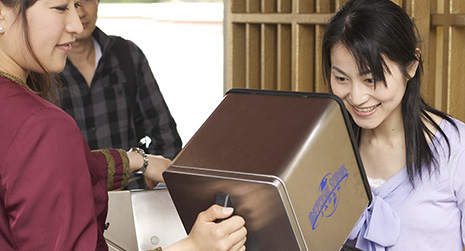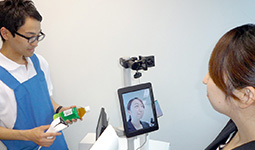Home > Highlighting JAPAN > Highlighting Japan January 2017 > Safety Firstx
Highlighting JAPAN


Face Value
Face recognition technology is being used in an increasingly wide range of applications around the world.
Amid the growing informatization of society and the spread of network services in recent years, more situations are encountered where it is necessary to identify oneself via machines. Doing this usually involves knowledge-based recognition with the use of information such as a password and identification number, or possession recognition using a magnetic card or an IC card. However, these methods are not sufficient because they entail the risk of a forgotten or leaked password, a stolen or counterfeited card and other issues. In this regard, biometric authentication has the advantage of risking none of these problems.
The current widely available technologies for biometric authentication involve the use of fingerprints, the veins of the palm or the iris of the eye, for example. More recently, face recognition has attracted attention. This has greater advantages than other biometric authentication technologies. The first advantage is that no special act is required for authentication. By saving users from the need to undertake operations such as holding their fingers or hands over a device, face recognition makes the authentication process faster and more convenient. Secondly, it imposes fewer psychological burdens on the user. Face recognition allows for a more natural form of authentication, because looking at a person’s face is a common means of identifying a specific individual.
As security measures have been intensified since the synchronized terrorist attacks in the United States in 2001, face recognition has been internationally utilized in visitor/immigrant status indicators, crime investigation systems and other parts of infrastructure concerning national security. In recent years, face recognition has become more familiar to the general public, because it is also utilized for corporate security and attendance management systems and theme parks’ entrance gate systems.
NEC Corporation, a leader in the integration of IT and network technologies, occupies the world’s top position in face recognition technology. NEC commenced its research on face recognition in 1989.
“Facial recognition is characteristically susceptible to influencers such as changes of light, shade, the direction in which a person looks and facial expressions. This poses the challenge of improving the accuracy of matching in many different environments,” explains Shunsuke Shiga, manager of the 2nd Government and Public Solutions Division at NEC Corporation. “For example, face recognition would require being able to correctly identify the same person after ten years, because Japanese passports are valid for ten years. A person with a sharply sculpted face may have shadows around his/her eyes depending on the amount of light. Even in such conditions, face recognition is expected to correctly authenticate the right individual.”
Accuracy and speed are particularly important in face recognition. For improvements in these areas, NEC is continuing to make efforts to research and develop technologies such as facial detection for identifying, from an image, the position of a specific face in a high-speed and highly accurate manner; point detection for accurately analyzing facial features irrespective of the degree of aging and changes in expressions; and highly accurate facial matching designed to thoroughly eliminate erroneous matching in any situation.
As a result, NEC’s face recognition technology won first place in the benchmark tests organized by the US National Institute of Standards and Technology (NIST) three consecutive times: in 2009, 2010 and 2013. In the 2013 test, NEC achieved an authentication error rate of 3.1%, less than half the rate of the company in second place, in terms of the accuracy of the retrieval of high-resolution facial images.
Today, NEC’s face recognition systems are utilized in more than forty countries in areas concerning national security. For example, John F. Kennedy International Airport in the United States is committed to the highly accurate identification of passengers through the real-time matching of facial photo data read by the automatic gate for immigration control from IC passports with images of travelers’ faces shot by the camera mounted on the gate. Furthermore, fourteen major airports in Brazil have introduced face recognition to customs, which contributes to streamlining the customs service by accurately identifying suspicious individuals from the records of past illegal acts.
“The application of face recognition will increasingly expand through improvements in the performance of surveillance cameras and other peripheral devices and data analysis technologies utilizing artificial intelligence,” says Shiga. “We will contribute to the greater security of society by developing technologies for preventing accidents.”
© 2009 Cabinet Office, Government of Japan








